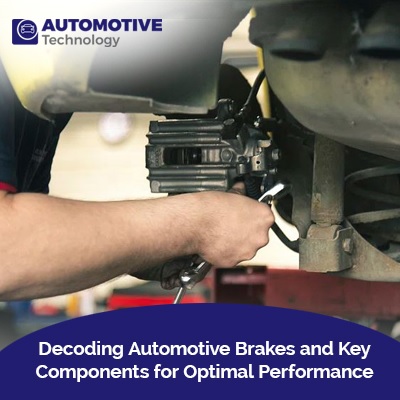Articles
Decoding Automotive Brakes and Key Components for Optimal Performance

Introduction:
In the competitive automotive industry, understanding the intricacies of brake systems is crucial for optimal performance and safety on the road. Whether you're a car enthusiast or simply a responsible driver, decoding the components that make up automotive brakes is essential knowledge. From brake pads to calipers, rotors, and brake fluid, each element plays a vital role in stopping your vehicle smoothly and efficiently. But what exactly are these components, and how do they work together to ensure optimal brake performance?
In this article, we will dive deep into the world of automotive brakes, unraveling the science behind the key components and exploring how they function. We'll take a closer look at the various types of brake systems available in the market and provide insights into choosing the right set-up for your vehicle.
Whether you're looking to upgrade your braking system or simply want to gain a better understanding of how it works, this article will serve as your comprehensive guide. Join us as we unlock the secrets behind automotive brakes and discover how they can elevate your driving experience.
The Importance of Optimal Brake Performance
Brakes are one of the most critical safety features in your vehicle, and their proper functioning is crucial for your safety and the safety of others on the road. Optimal brake performance ensures that your vehicle stops quickly and efficiently, reducing the risk of accidents and collisions. Additionally, a well-maintained braking system enhances the overall driving experience, providing a smooth and comfortable ride.
Understanding the Key Components of Automotive Brakes
Brake Pads: Types, Materials, and Maintenance
Brake pads are an essential component of any braking system. They are the friction material that makes contact with the brake rotors to slow down or stop the vehicle. There are different types of brake pads available in the market, including organic, semi-metallic, and ceramic. Each type has its advantages and disadvantages, and choosing the right one depends on factors such as driving style, vehicle type, and budget.
Maintenance of brake pads is crucial for optimal performance and longevity. Regular inspections and replacement when necessary are important to ensure that the brake pads are in good condition. Additionally, proper bedding-in of new brake pads is essential to maximize their effectiveness and minimize noise and vibrations.
Brake Rotors: Types, Materials, and Maintenance
Brake rotors, also known as brake discs, are the circular metal discs that the brake pads clamp onto to create friction and slow down the vehicle. Like brake pads, there are different types of brake rotors available, including solid, vented, and slotted. Each type has its advantages and is suitable for different driving conditions.
The choice of brake rotor material is also important. Common materials used for brake rotors include cast iron, carbon composite, and ceramic. Each material has its characteristics in terms of heat dissipation, durability, and performance. Regular inspection and maintenance of brake rotors, including checking for wear and warping, are essential for optimal brake performance.
Brake Calipers: Function, Types, and Maintenance
Brake calipers are the components that house the brake pads and apply pressure to them to create friction against the brake rotors. They play a crucial role in converting hydraulic pressure from the brake fluid into mechanical force to stop the vehicle. There are different types of brake calipers, including floating calipers, fixed calipers, and sliding calipers, each with its design and function.
Proper maintenance of brake calipers is important to ensure optimal performance. Regular inspection and cleaning of the caliper pistons, slide pins, and seals help prevent issues such as sticking or seizing. Additionally, proper lubrication of moving parts and regular brake fluid flushes contribute to the longevity and effectiveness of the brake calipers.
Brake Fluid: Importance, Types, and Maintenance
Brake fluid is a hydraulic fluid that transfers the force from the brake pedal to the brake calipers, enabling the braking system to function. It plays a crucial role in transmitting the pressure applied to the brake pedal to the brake pads, allowing them to create friction against the brake rotors.
There are different types of brake fluid, including DOT 3, DOT 4, and DOT 5.1, each with its own characteristics and boiling points. Choosing the right type of brake fluid is important to ensure compatibility with your vehicle's braking system and to meet the required performance standards. Regular maintenance of brake fluid is essential to maintain optimal brake performance. Brake fluid absorbs moisture over time, which can lead to a decrease in its boiling point and affect its effectiveness. Regular inspections and flushes of the brake fluid help ensure that it is clean and free from contaminants.
Brake Lines and Hoses: Importance, Types, and Maintenance
Brake lines and hoses are responsible for transmitting the brake fluid from the master cylinder to the brake calipers. They play a critical role in maintaining the integrity and functionality of the braking system.
There are different types of brake lines and hoses, including steel lines and flexible rubber hoses. Each type has its advantages and is suitable for different applications. Steel lines provide durability and resistance to corrosion, while flexible rubber hoses allow for movement and flexibility. Regular inspection of brake lines and hoses is important to identify any signs of wear, leaks, or damage. Replacement of damaged or deteriorated lines and hoses is crucial to maintain the integrity of the braking system and prevent brake failure.
Signs of Brake System Issues and When to Seek Professional Help
Despite regular maintenance, brake systems can develop issues over time. It is important to be aware of the signs of brake system problems and take appropriate action to ensure your safety on the road. Some common signs of brake system issues include squealing or grinding noises, a spongy or soft brake pedal, vibrations or pulsations when braking, and a longer stopping distance.
If you notice any of these signs, it is important to seek professional help and have your brake system inspected and repaired by a qualified technician. Ignoring brake system issues can lead to further damage and compromise your safety on the road.
Conclusion and Tips for Maintaining Optimal Brake Performance
In conclusion, understanding the key components of automotive brakes and how they function is essential for optimal brake performance and safety. Brake pads, rotors, calipers, brake fluid, and brake lines all work together to ensure smooth and efficient stopping power.
Regular maintenance and inspections are crucial to ensure that your braking system is in good condition. Pay attention to signs of brake system issues and seek professional help when necessary. By taking care of your brakes and choosing the right components, you can enjoy a safe and enjoyable driving experience. Remember, brakes are not something to be taken lightly. They are a crucial part of your vehicle's safety system, and investing in their maintenance and proper functioning is essential for your well-being on the road. So, take the time to decode the intricacies of automotive brakes and ensure optimal performance for a smooth and safe ride.
The above article is a comprehensive guide to understanding the key components of automotive brakes and their role in ensuring optimal performance and safety. It covers the importance of optimal brake performance, the different types of brake components, their materials, maintenance, and signs of brake system issues. By following the tips provided in this article, drivers can maintain their brake systems and enjoy a smooth and safe driving experience.


